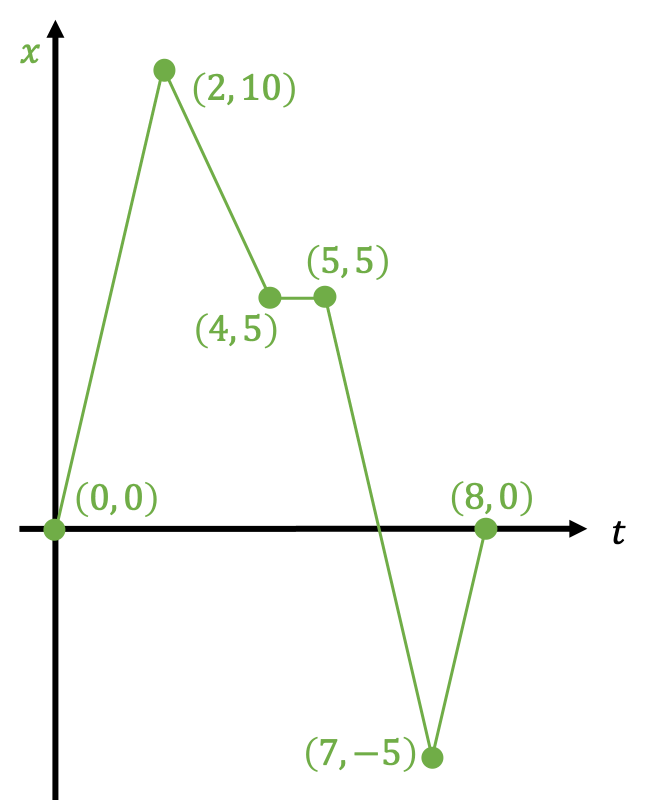Newton’s Laws and Kinematic Equations (Solutions)
The following solutions are for the problems on introduction to physics, Newton's Laws, and kinematic equations linked here. I encourage you to attempt them by yourself first before looking through the solutions.
Problem 1
A graph of position $x$ versus time for a certain particle moving along the $x$-axis is shown here in green:

Find the average velocity in the time intervals between...
- 0 to 2 sec
- 0 to 4 sec
- 2 to 4 sec
- 4 to 7 sec
- 0 to 8 sec
To solve this problem, we use the formula for velocity $v=\frac{x_f-x_i}{t_f-t_i}$:
0 to 2 sec: $\quad \vec{v}_{\text{avg}}=\frac{(10-0)\text{ units}}{(2-0)\text{ sec}}\hat{x}=5\text{ units}\cdot\text{sec}^{-1}\hat{x}$
0 to 4 sec: $\quad \vec{v}_{\text{avg}}=\frac{(5-0)\text{ units}}{(4-0)\text{ sec}}\hat{x}=\frac{5}{4}\text{ units}\cdot\text{sec}^{-1}\hat{x}$
2 to 4 sec: $\quad \vec{v}_{\text{avg}}=\frac{(5-10)\text{ units}}{(4-2)\text{ sec}}\hat{x}=\frac{5}{2}\text{ units}\cdot\text{sec}^{-1}\left(-\hat{x}\right)$
4 to 7 sec: $\quad \vec{v}_{\text{avg}}=\frac{(-5-5)\text{ units}}{(7-4)\text{ sec}}\hat{x}=\frac{10}{3}\text{ units}\cdot\text{sec}^{-1}\left(-\hat{x}\right)$
0 to 8 sec: $\quad \vec{v}_{\text{avg}}=\frac{(0-0)\text{ units}}{(8-0)\text{ sec}}\hat{x}=0\text{ units}\cdot\text{sec}^{-1}\hat{x}$
Problem 2
An electron is traveling in the $+\hat{x}$ direction at an initially constant speed of $v=2.10\times 10^7\text{ m}\cdot\text{sec}^{-1}$. The electron enters an electric field at time $t=0$ that deflects the electron by giving it a constant acceleration of $5.30\times 10^{15}\text{ m}\cdot\text{sec}^{-2}$ in the $+\hat{y}$ direction.
- How long does it take for the electron to cover a horizontal distance of $6.2\times10^{-2}\text{ m}$?
- What is the vertical displacement of the electron during this time?
This problem is an example of applying kinematic equations to two dimensions. We will break up this problem into two 1-dimensional problems.
In the $\hat{x}$ direction, there is no net acceleration given in the problem, so $a_x=0$. We also have an initial speed $v_{ix}=2.10\times10^7\text{ m}\cdot\text{sec}^{-1}$ given in the problem. Therefore, if we want to know how long $t$ it takes to dover a distance of $6.2\times10^{-2}\text{ m}$ in the $\hat{x}$ direction, then we have
\[\Delta x=v_{ix}t+\frac{1}{2}a_xt^2=v_{ix}t\longrightarrow t=\frac{\Delta x}{v_{ix}}\]since $a_x$ is zero. Plugging in the parameters of the problem, we find
$$t=\frac{6.2\times10^{-2}\text{ m}}{2.10\times10^7\text{ m}\cdot\text{sec}^{-1}}\approx 2.95\times10^{-9}\text{ sec}$$
For the second part of the problem, we are interested in finding the vertical displacement $\Delta y$ in the $\hat{y}$ direction. In the $\hat{y}$ direction, the initial velocity is $v_{iy}=0\text{ m}\cdot\text{sec}^{-1}$, and there is given to be an acceleration in the $+\hat{y}$ direction with magnitude $a_y=5.30\times 10^{15}\text{ m}\cdot\text{sec}^{-2}$. Since the acceleration is also a constant in this direction, we can use this information to calculate the vertical displacement using the appropriate kinematic equation:
\[\Delta y=v_{iy}t+\frac{1}{2}a_yt^2=\frac{1}{2}a_yt^2\]where we have used the fact that $v_{iy}$ is $0$. Plugging in the values, we have
\[\Delta y=\frac{1}{2}\left(5.30\times10^{15}\frac{\text{m}}{\text{sec}^2}\right)\left(2.95\times10^{-9}\text{ sec}\right)^2\]Numerically simplifying,
$$\Delta y=2.31\times10^{-2}\text{ m}$$
Problem 3
Consider a one-dimensional system with a position-dependent force $F(x)$ acting on a particle over the entirety of the real number line.
- Take $F(x)=e^{-\vert x\vert}$. What is the work required to 'push' the particle from $x=-1$ to $x=1$?
- Take $F(x)=e^{-\vert x\vert}$. What is the work required to 'push' the particle from $x=-\infty$ to $x=\infty$?
- Take $F(x)=xe^{-x}$. What is the total energy stored in the system between $x=0$ and $x=\infty$?
- It is not possible to calculate the total energy of the system described in Part (3) above from $x=-\infty$ to $x=\infty$. Why? Hint: What is the value of $F(x)$ at $x=-\infty$?
This problem is meant to serve as a review of calculus and a direct application of the definition of work we learned earlier. For the purposes of this problem, we will denote the work required to push the particle from $x=a$ to $x=b$ as $W_{a\rightarrow b}$, and the energy stored in the system between $x=a$ and $x=b$ as $U_{a\rightarrow b}$.
$$W_{-1\rightarrow 1}=\int_{-1}^1dx F(x)=\int_{-1}^1dx e^{-\vert x\vert}=2\int_0^1dxe^{-x}=-2\left.e^{-x}\right\vert_0^1=2(1-e^{-1})$$
$$W_{-\infty\rightarrow \infty}=\int_{-\infty}^{\infty}dx F(x)=\int_{-\infty}^{\infty}dx e^{-\vert x\vert}=2\int_0^{\infty}dxe^{-x}=-2\left.e^{-x}\right\vert_0^{\infty}=2$$
Since energy $U$ is defined by the equation $$U=\frac{-dF}{dx}$$ we know that $$U_{0\rightarrow \infty}=-\int_0^{\infty}dx\text{ }xe^{-x}$$ This integral can be evaluated using integration by parts.
$$U_{0\rightarrow \infty}=-\int_0^{\infty}dx\text{ }xe^{-x}=\left.xe^{-x}\right\vert_0^{\infty}-\int_0^{\infty}e^{-x}=\left.e^{-x}\right\vert_0^{\infty}=1$$
Finally, as per the hint given in the problem, it is not possible to calculate the total energy of the system from $x=-\infty$, because $F(x\rightarrow \infty)=(-\infty)e^{\infty}=-\infty$. We cannot sum an infinite amount of force to calculate the energy. Because the integral for the energy diverges, we cannot calculate the total energy of the system.